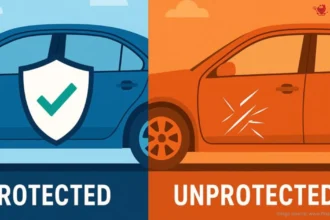Introduction: Maximizing Your Savings Potential

In today’s financial landscape, traditional savings accounts are delivering disappointingly low returns, with many major banks offering as little as 0.10% APY. Meanwhile, high-yield savings accounts are providing significantly better opportunities, with top rates reaching up to 4.75% APY as of February 2025. This dramatic difference means your money could be working over 11 times harder for you with minimal effort on your part.
Whether you’re building an emergency fund, saving for a major purchase, or simply want to make your extra cash work harder, opening a high-yield savings account is one of the smartest financial moves you can make. This comprehensive guide will walk you through everything you need to know about finding, comparing, and opening a high-yield savings account that best matches your financial goals and situation.
What Is a High-Yield Savings Account?
A high-yield savings account is fundamentally similar to a traditional savings account but offers significantly higher interest rates. These accounts typically pay 10-12 times the national average rate, which was 0.41% APY as of February 2025. While they function like standard savings accounts—allowing deposits and withdrawals—the elevated interest rates dramatically improve your earning potential.
These accounts are most commonly offered by online banks or online divisions of traditional banks, which can afford to provide better rates due to their lower overhead costs compared to maintaining physical branch locations. By eliminating the expenses associated with brick-and-mortar operations, online banks pass those savings to customers in the form of higher interest rates.
High-Yield Savings vs. Traditional Savings: A Real-World Comparison
To understand the practical impact of these higher rates, consider this example:
Let’s say you deposit $1,000 in a high-yield savings account earning 4.75% APY and contribute $100 monthly. After one year, you’ll earn approximately $73.41 in interest, bringing your balance to $2,273.41.
By contrast, the same initial deposit and monthly contribution in a traditional savings account paying 0.10% APY (typical of major banks like Chase, Wells Fargo, and U.S. Bank) would earn just $1.55 in interest after a year, resulting in a balance of $2,201.55.
That’s a difference of nearly $72 in just one year—and the gap only widens as your balance grows and time passes.
Why You Should Open a High-Yield Savings Account
Before diving into the step-by-step process, let’s examine why high-yield savings accounts have become so popular among savvy savers:
1. Significantly Higher Returns
The most obvious benefit is the substantial increase in interest earnings. Earning 4.75% versus 0.10% means your money grows nearly 48 times faster.
2. Safety and Security
High-yield savings accounts at FDIC-insured banks or NCUA-insured credit unions offer the same federal protection as traditional accounts—up to $250,000 per depositor, per institution.
3. Liquidity and Accessibility
Unlike certificates of deposit (CDs) or investment accounts, high-yield savings accounts maintain liquidity, allowing you to access your funds when needed without penalties, though some may limit monthly withdrawals.
4. Goal-Based Saving Potential
These accounts provide an excellent vehicle for specific savings goals like emergency funds, down payments, vacations, or major purchases. The higher interest rate helps you reach your targets faster.
5. Separation from Day-to-Day Finances
Keeping your savings at a different institution from your checking account creates a psychological barrier that can reduce impulse spending while still allowing access when truly needed.
READ ALSO: Best High Yield Savings Accounts of 2024: A Finance Devil Guide to Maximizing Your Savings
How to Find the Best High-Yield Savings Account
Finding the right high-yield savings account requires research and comparison. Here’s how to identify the best options for your financial situation:
1. Research Current Competitive Rates
As of February 2025, the highest available rates nationwide reached 4.75% APY, but these rates fluctuate based on the Federal Reserve’s monetary policy. Some of the top-paying institutions as of February 2025 include:
- Neighbors Bank: 4.75% APY
- Openbank: 4.75% APY
- Pibank: 4.60% APY
- BrioDirect: 4.55% APY
- Fitness Bank: 4.55% APY
Remember that rates change frequently, so it’s worth checking current offers before making a decision.
2. Consider Account Requirements and Restrictions
When comparing accounts, look beyond the headline APY and examine:
- Minimum opening deposit requirements: These range from any amount (no minimum) to as high as $25,000 for premium accounts.
- Ongoing minimum balance requirements: Some accounts require maintaining certain balances to avoid fees or to qualify for the advertised rate.
- Monthly maintenance fees: Many high-yield accounts have no monthly fees, but some may charge unless you meet specific conditions.
- Withdrawal limitations: Some accounts restrict the number of withdrawals you can make each month.
- Compound frequency: Daily compound interest will grow your money faster than monthly compounding.
3. Evaluate Account Features and Access Options
Consider what features and functionality matter most to you:
- Mobile app quality: If you plan to manage your account primarily through a smartphone, a robust, user-friendly mobile app is essential.
- Transfer capabilities: How easy is it to move money between this account and your primary bank?
- ATM access: Some high-yield savings accounts offer ATM cards for withdrawals, though many don’t.
- Customer service availability: Are representatives available 24/7, or only during limited hours?
- Additional account options: Does the institution offer other competitive products like checking accounts or CDs that might benefit you?
4. Check Institution Reputation and Security
Before entrusting your money to any financial institution:
- Verify FDIC or NCUA insurance coverage (protecting up to $250,000 per depositor)
- Read customer reviews and ratings
- Check complaint databases like the Consumer Financial Protection Bureau
- Research the institution’s history and financial stability
Step-by-Step: How to Open a High-Yield Savings Account
Once you’ve identified the best high-yield savings account for your needs, opening an account is typically straightforward. Here’s a detailed walkthrough:
Step 1: Gather Your Personal Information and Documentation
Before starting the application process, have these items ready:
- Social Security Number (SSN) or Taxpayer Identification Number (TIN)
- Valid government-issued photo ID (driver’s license, passport, state ID)
- Current address information
- Contact information (email address, phone number)
- Employment information (optional for some institutions)
- Existing bank account information for funding your new account
Step 2: Complete the Online Application
Most high-yield savings accounts can be opened entirely online through these steps:
- Visit the financial institution’s website and navigate to their savings account offerings
- Select the high yield savings account product
- Click the “Open Account” or “Apply Now” button
- Choose whether you want an individual or joint account
- Enter your personal information as requested
- Create login credentials (username, password, security questions)
- Review and accept the terms and conditions
- Submit your application
The entire process typically takes about 10 minutes to complete.
Step 3: Verify Your Identity
Financial institutions are legally required to verify your identity under Know Your Customer (KYC) and anti-money laundering regulations. This verification may involve:
- Electronic verification using the information you provided
- Additional documentation requests if automatic verification fails
- Small test deposits to any linked external accounts
- Phone or email verification
Step 4: Fund Your Account
Most institutions offer several methods to make your initial deposit:
Electronic transfer from an existing bank account:
- Provide your current bank’s routing number and your account number
- Specify the amount to transfer
- Authorize the transaction
Mobile check deposit:
- Download the bank’s mobile app
- Use the mobile check deposit feature
- Follow prompts to photograph the front and back of your endorsed check
Mail a physical check:
- Write a check from your existing account
- Mail it to the address provided by your new bank
- Include any required deposit slips or account information
Direct deposit: Some institutions allow you to set up direct deposit from your employer as the initial funding source.
Be aware of any minimum opening deposit requirements. These can range from no minimum to $25,000 or more, depending on the account.
Step 5: Set Up Online and Mobile Banking
For optimal account management:
- Download the financial institution’s mobile app from your device’s app store
- Log in using the credentials you created during application
- Set up biometric authentication (fingerprint or face recognition) if available
- Explore app features and customize settings according to your preferences
- Enable account notifications and alerts for security and tracking
Step 6: Link External Accounts for Easy Transfers
To facilitate moving money between your high-yield savings and other accounts:
- Locate the “Link External Account” or “Add Account” option in your online banking portal
- Provide the routing and account numbers for your external account
- Verify the link through small test deposits (typically two deposits under $1)
- Set up recurring transfers if desired (great for automatic savings)
Step 7: Designate Beneficiaries
For estate planning purposes:
- Find the beneficiary designation section in your online account settings
- Enter the required information for your primary beneficiary (name, relationship, SSN, contact information)
- Add contingent beneficiaries if desired
- Review and confirm your selections
Step 8: Opt for Electronic Statements
Many online banks:
- Require electronic statements
- Charge fees for paper statements
- Offer incentives for going paperless
Electronic statements also reduce paper waste and minimize identity theft risk from mail theft.
Maximizing Your High-Yield Savings Account

Once your account is open, implement these strategies to get the most benefit:
Set Up Automatic Transfers
Establish regular automatic transfers from your checking account to your high-yield savings account. This “pay yourself first” approach ensures consistent saving without requiring ongoing effort or discipline.
Create Targeted Sub-Accounts
Some high-yield savings accounts allow you to create multiple sub-accounts or savings goals within a single account. This feature helps you organize your savings for specific purposes—emergency fund, vacation, home down payment—while earning the high interest rate on all your funds.
Monitor Interest Rate Changes
High-yield savings account rates aren’t fixed—they typically move in tandem with Federal Reserve rate adjustments. Stay informed about rate trends and be prepared to move your money if your bank’s rate becomes significantly less competitive than alternatives.
Utilize Rate Guarantees
Some institutions offer rate guarantees for a specified period. These can provide stability in a falling rate environment, though they may come with additional requirements.
Maintain Qualifying Activities
If your account has requirements to earn the highest rate (minimum balance, direct deposit, etc.), set up systems to ensure you consistently meet these conditions.
Common Challenges and Solutions
Challenge: Delayed Access to Funds
Solution: Maintain a smaller buffer in your primary checking account to handle immediate needs while transfers process (typically 1-3 business days).
Challenge: Account Management Across Multiple Institutions
Solution: Use a financial aggregation app like Mint, Personal Capital, or YNAB to view all your accounts in one dashboard.
Challenge: Meeting Minimum Balance Requirements
Solution: Set up balance alerts to notify you if your account approaches the minimum threshold, giving you time to transfer additional funds.
Challenge: Remembering Multiple Login Credentials
Solution: Use a secure password manager like LastPass, 1Password, or Bitwarden to safely store and manage your banking credentials.
Challenge: Earning Less Than Expected
Solution: Understand how APY is calculated and when interest is credited to your account. Compound interest takes time to build, so be patient as your balance grows.
Special Considerations for Different Financial Situations
For Emergency Funds
When using a high-yield savings account for your emergency fund (typically recommended to cover 3-6 months of expenses):
- Focus more on accessibility and flexibility than marginally higher rates
- Consider keeping some emergency funds in an account linked directly to your checking for immediate access
- Look for accounts without withdrawal penalties or excessive limitations
For Major Purchase Savings
If you’re saving for a specific goal with a definite timeline:
- Consider whether a CD might offer better rates if you won’t need the money before a certain date
- Use calculators to determine how much you need to save monthly to reach your goal
- Set up automatic deposits aligned with your target date
For Retirement Supplementary Savings
While high-yield savings accounts shouldn’t replace proper retirement investments:
- They can serve as a holding place for funds you plan to invest soon
- They provide a safe haven for money you might need within 1-2 years
- They can complement your investment portfolio as the cash/liquid portion
For Business Owners
Business high-yield savings accounts offer specific advantages:
- Separate business and personal finances
- Build business emergency funds
- Set aside money for taxes or major expenses
- Some institutions offer business-specific features and higher rates
Expert Insights: What Financial Advisors Say
Financial advisors consistently recommend high-yield savings accounts for specific purposes:
“When a client has money they won’t need in the next 12 to 24 months, I encourage them to take advantage of a high-yield savings account or money market account to hedge against inflation as well remove the funds from their actively used checking accounts. Basically, a ‘hands off account,'” says Sibyl Slade, a financial advisor quoted by Investopedia.
Other expert recommendations include:
- Using high-yield savings accounts as a stepping stone in a ladder approach to savings and investments
- Maintaining emergency funds in high-yield accounts rather than checking accounts
- Splitting savings between high-yield accounts and other instruments based on timelines and goals
High-Yield Savings Accounts vs. Alternatives
High-Yield Savings vs. Traditional Savings Accounts
While both offer security and liquidity, high-yield accounts typically provide:
- 10-12 times higher interest rates
- Often better online and mobile features
- Fewer physical branch services
- Similar FDIC/NCUA insurance protection
High-Yield Savings vs. Money Market Accounts
Money market accounts traditionally offered:
- Check-writing privileges (though many modern “money market” accounts don’t include this feature)
- Historically higher rates than savings accounts (though today many high-yield savings accounts offer competitive or better rates)
- Similar FDIC/NCUA insurance protection
- Potentially higher minimum balance requirements
High-Yield Savings vs. Certificates of Deposit (CDs)
CDs typically offer:
- Fixed rates for the entire term (unlike variable-rate savings accounts)
- Potentially higher rates for longer commitments
- Penalties for early withdrawal
- Less flexibility for adding funds during the term
High-Yield Savings vs. Investment Accounts
Investment accounts (brokerage, mutual funds, etc.) offer:
- Potential for significantly higher returns
- Much higher risk potential, including possible loss of principal
- Less liquidity in some cases
- No FDIC/NCUA insurance (though some have SIPC protection against broker failure)
Future Trends: What to Expect for High-Yield Savings Accounts
Several trends are shaping the future of high-yield savings accounts:
Interest Rate Environment
As of February 2025, the Federal Reserve has been gradually reducing interest rates, with the federal funds rate at 4.25%-4.50%. This suggests high-yield savings rates may continue to trend downward in the coming year, though they remain historically attractive.
Digital Banking Innovations
Expect to see:
- Enhanced mobile features and user experiences
- AI-powered savings recommendations and insights
- More seamless integration with other financial services
- Improved security features like advanced biometrics
Competition and Market Evolution
The high-yield savings marketplace is becoming increasingly competitive, with:
- Traditional banks launching competitive online offerings
- Fintech companies partnering with banks to offer innovative products
- Niche offerings targeting specific demographics or needs
- Bundled services that reward customers using multiple products
Conclusion: Taking the Next Steps
Opening a high-yield savings account represents one of the simplest yet most effective financial moves you can make to improve your money management. With potential returns more than 10 times higher than traditional savings accounts, these federally-insured accounts provide an excellent balance of safety, accessibility, and growth potential.
As you’ve seen throughout this guide, the process of opening and managing a high-yield savings account is straightforward, typically requiring just minutes of your time. The rewards—potentially dozens or even hundreds of dollars in additional interest annually—make this minimal effort well worthwhile.
To recap the key steps to opening your high-yield savings account:
- Research current competitive rates and account features
- Compare minimum requirements and fee structures
- Gather your personal information and documentation
- Complete the online application
- Fund your account
- Set up online/mobile banking and link external accounts
- Establish automatic transfers to grow your savings consistently
The financial landscape is constantly evolving, with interest rates and account features changing regularly. By staying informed about current offers and maintaining awareness of how your account compares to competitors, you can ensure your money continues working as hard as possible for you.
Don’t let inertia or convenience keep your hard-earned money earning minimal returns in a traditional savings account. Take action today to open a high-yield savings account and put your savings on an accelerated growth path.
Ready to boost your savings? Compare current high-yield savings account rates today and open an account that matches your needs. Even a few minutes of your time could translate to significantly more money in your pocket over the coming months and years.
Frequently Asked Questions About High-Yield Savings Accounts
Are high-yield savings accounts safe?
Yes. High-yield savings accounts at FDIC-insured banks or NCUA-insured credit unions provide the same federal protection as traditional accounts—up to $250,000 per depositor, per institution. This insurance means your money is protected even if the bank fails.
Can I lose money in a high-yield savings account?
The risk of losing money in a high-yield savings account is extremely low. Your principal is protected, and interest rates, while variable, are guaranteed based on your balance. The only potential “losses” would come from fees that exceed your interest earnings, which is rare with proper account management.
How often do interest rates change on high-yield savings accounts?
Interest rates on high-yield savings accounts are variable and can change at any time without notice. However, rate changes typically occur following Federal Reserve actions, which are announced after their scheduled meetings (approximately eight times per year). Between Fed actions, rates often remain stable for weeks or months.
How many high-yield savings accounts can I have?
There’s no legal limit to how many savings accounts you can open. You can have multiple accounts at different banks to take advantage of various features or to organize your savings for different goals. Just remember that FDIC/NCUA insurance limits ($250,000) apply per depositor, per institution.
Do I have to pay taxes on the interest earned?
Yes. Interest earned in a high-yield savings account is considered taxable income. Your bank will send you and the IRS a Form 1099-INT in January each year that shows how much interest you earned during the previous tax year. You must report this interest income on your tax return.
Can I open a high-yield savings account with bad credit?
Yes. Unlike loan applications, opening a savings account typically doesn’t require a credit check. However, banks may use ChexSystems or similar services to review your banking history for previous issues like overdrafts or account closures. Some banks offer “second chance” accounts if you have previous banking problems.
How quickly can I access my money in a high-yield savings account?
Access time varies by institution and withdrawal method:
- Internal transfers to linked checking accounts at the same bank: Often instant
- External transfers to other banks: Typically 1-3 business days
- ATM withdrawals (if available): Immediate, but may have daily limits
- Check withdrawals (if available): Subject to standard check clearing times
How do online-only banks work for deposits and withdrawals?
Online-only banks typically offer several methods for moving money:
- ACH transfers from/to linked external accounts
- Mobile check deposit through the bank’s app
- Direct deposit from employers or government benefits
- ATM access through networks (some online banks reimburse ATM fees)
- Some online banks provide postage-paid envelopes for mailing checks
In another related article, High-Yield Savings Accounts: Maximizing Your Money in 2025’s Competitive Market





